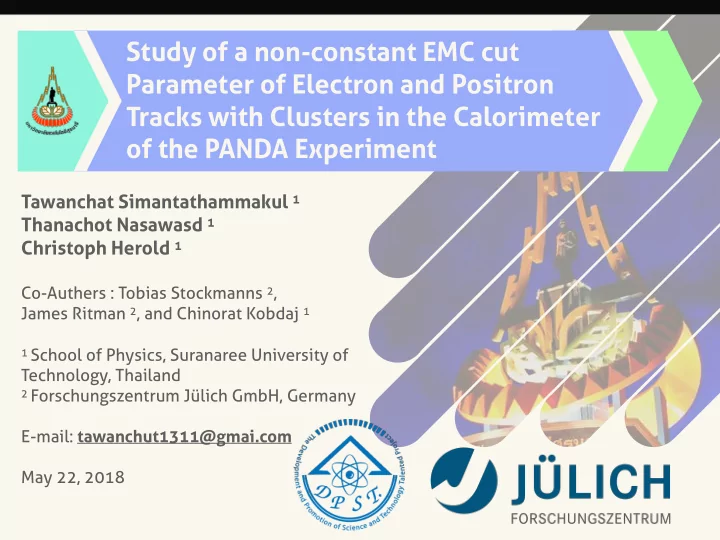

Study of a non-constant EMC cut Parameter of Electron and Positron Tracks with Clusters in the Calorimeter of the PANDA Experiment Tawanchat Simantathammakul 1 Thanachot Nasawasd 1 Christoph Herold 1 Co-Authers : Tobias Stockmanns 2 , James Ritman 2 , and Chinorat Kobdaj 1 1 School of Physics, Suranaree University of Technology, Thailand 2 Forschungszentrum Jülich GmbH, Germany E-mail: tawanchut1311@gmai.com May 22, 2018
Outline Introduction PANDA Experiment PandaRoot, Monte Carlo Simulation Reconstruction of Charged Particle Tracks in PandaRoot Classification of EMC clusters Methodology Verification Matches Calculation of EMC Cut Parameter Non-Constant EMC Cut Results and Discussion Conclusion � 2
Introduction PANDA Experiment GSI Helmholtz Centre for Heavy Ion Research Facility for Antiproton and Ion Research antiProton ANnihilation at DArmstadt The construction site of PANDA experiment, The Geometry of PANDA Detector. taken on September 3, 2017 (photo: Till Middelhauve for FAIR) Retrieved from https://panda.gsi.de/oldwww/framework/detector.php � 3
Introduction PandaRoot, Monte Carlo Simulation Event Generator The Geometry of PADNA Detector in Digitization PandaRoot Simulation Framework Reconstruction Particle Identification The PADNA Detector Simulation with Particle Events � 4
Introduction Reconstruction of Charged Particle Tracks in PandaRoot Electromagnetic Calorimeter (EMC) is scintillator detector used to measure energy of the particle via the electromagnetic interaction. S traw Tube Tracker (STT) is one type of gaseous ionization EMC Cluster chamber, they are used as central tracking system Particle Trajectory Propagated Track Collision Point � 5
Introduction Classification of EMC Clusters To classify the associated EMC clusters with the Three EMC clusters on EMC Surface propagated point, we consider • Time when the particle reach EMC surface. • The closest cluster to the propagated point, which the shortest distance is defined by • The distance must below a cut o ff parameter, which is equal to 2,500 cm 2 . Trajectory Particle Propagated Track The EMC quality depends on transverse momentum. EMC cut should also depend! The EMC quality as function of transverse momentum � 6 for single-electron events.
Methodology Verification Matches Box Generator Generate single-particle event. Monte Carlo Truth Information ID of signal that stores in root files. The EMC quality where we distinguish between correct matches, incorrect matches, and multiple matches Number of Track Per Event ID of Propagated Track ID of EMC cluster Multiple Match Correct Match Incorrect Match More than one track in these Track and Cluster come from track and Cluster come from events. the same MCTrack. the di ff erent MCTrack. � 7
Methodology Calculation of EMC Cut Parameters Acceptance percentage • The ratio of number correct matches that has EMC quality less than EMC cut to the total number of correct matches. • We use this parameter to calculate the EMC cut by find the EMC quality that provides cumulative frequency reach acceptance percentage. The cumulative frequency of EMC quality for single-electron event in transverse momentum range 0.3 - 0.4 GeV/c The acceptance percentages in this work are 85%, 90%, and 95% respectively. And we do this for all 0.1 GeV/c momentum bin. � 8
Methodology Non-Constant EMC Cut • the first peak is power-law distribution because at low momentum, particle might not reach the EMC surface, that mean the distance between will be infinite value. • For the skewed peak, it might be Landau distribution because this distribution use to describe the energy loss of charged particle traveling in matter, but we use approximate form, known as the Moyal function. 1st-Moyal 2nd-Moyal Power-law � 9
Results and Discussion The EMC Cut Equations The table of fit parameter for electron and acceptance The EMC cut for electron as function of transverse momentum, for di ff erent acceptance � 10
Results and Discussion Testing The EMC Cut Purity vs. Acceptance Completeness vs. Acceptance � 11
Conclusion • In this work, we developed the EMC cut for PandaRoot simulation framework to classify EMC cluster and propagated track. • By varying the cut parameter as a function of transverse momentum which is defined by power-law and double-Moyal functions. • Our simulations show that the purity of both particles species can be increase by 3-4% compared to the default value. • Next we are aiming to do, is we will try to understand the physical meaning of each parameter in the equation and try apply the machine learning to this project. � 12
Thanks For Your Attention � 13
Recommend
More recommend